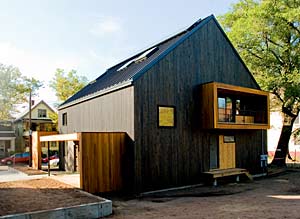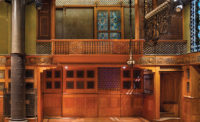Yale students have constructed a prototypical residence in New Haven, Connecticut, for a disabled female veteran of the U.S. Armed Forces and her family. Responsible for both design and construction, 64 students took the project from start to finish in just over five months as part of the Yale architecture school's Building Project, a mandatory course for first-year graduate students. This year's project was completed in collaboration with nonprofit developer Common Ground and the Connecticut Veterans Administration at a cost of $200,000'in addition to plenty of free labor and donated materials.


Yale architecture students have built a house in New Haven, Connecticut, for a disabled female veteran. Responsible for both design and construction, 64 students took the project from start to finish in just over five months.
“The brief was to design and construct a two-family house for a female veteran returning from either the conflict in Afghanistan or Iraq, in order to address the burgeoning crisis of homelessness related to veterans,” says project director Adam Hopfner. Indeed, the National Alliance to End Homelessness estimates that veterans represent roughly 26 percent of homeless people, but only 11 percent of the civilian adult population.
The students originally split into seven teams and were given five weeks to develop proposals. After presentations to Yale faculty and partner organizations, one scheme emerged as the winner: a home with a 1,500-square-foot ground-floor unit for the owner and a 600-square-foot apartment for a tenant, to help offset mortgage costs.
All students regrouped to finalize the chosen design; one week later, construction began. “There was a whole host of decisions that were made on the fly once the walls were going up,” says student J. D. Messick. “It’s a fun and unique opportunity to be there on-site, constructing the house, and to know that everything isn’t set in stone.”
The project, completed in late August, went beyond providing the emerging architects with an educational experience. Given its flexible design and considerations related to accessibility, Messick says the house is a good candidate for reproduction. “Common Ground noted that this project might be something of a prototype for future development on a variety of different sites,” he says.





Post a comment to this article
Report Abusive Comment